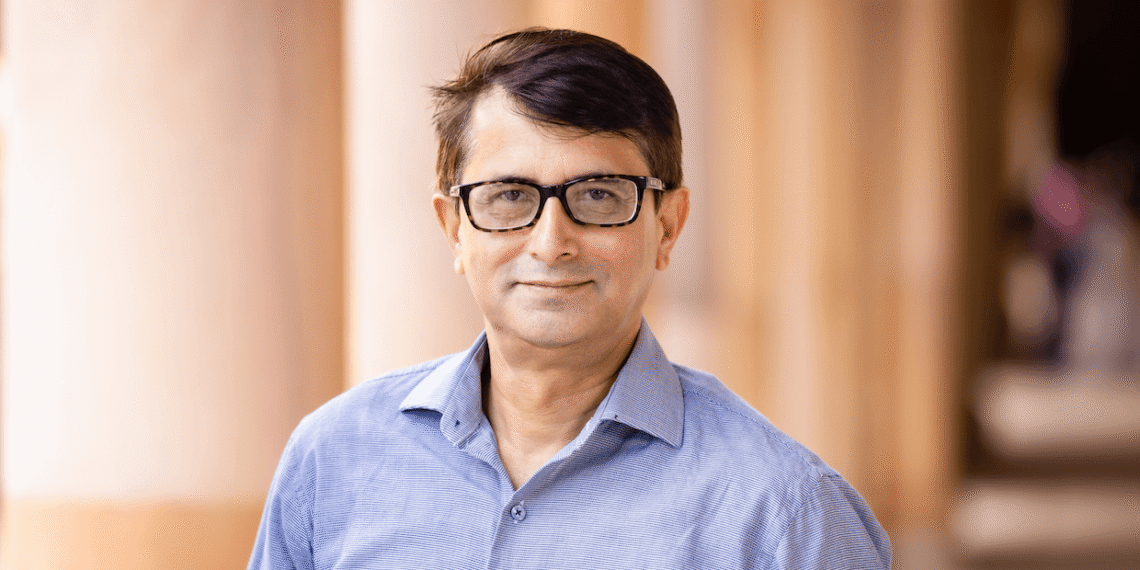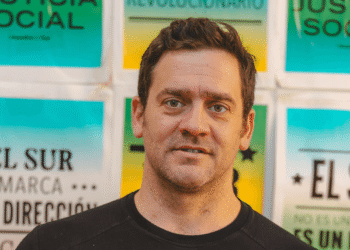“Transitional Nepal may face real dangers from rising religious populism,” cautions Dr. DB Subedi, lecturer in Peace and Conflict Studies at the University of Queensland, in an interview with the ECPS. While the September 2025 youth-led uprising signaled a break with entrenched corruption, nepotism, and elite capture, Dr. Subedi warns that Nepal’s weak secularism leaves space for actors seeking to reinstate Hindu statehood. Such a trajectory, he argues, risks fusing populist nationalism with sectarian identity—posing a greater threat than conventional elite dominance. Yet he also sees in Gen Z’s unprecedented mobilization the embryonic signs of a participatory, post-elitist democracy. Much depends, he stresses, on whether Nepal’s interim government can ensure a smooth, accountable transition to elections.
Interview by Selcuk Gultasli
“Transitional Nepal may face real dangers from rising religious populism,” warns Dr. DB Subedi, a leading scholar of peace and conflict studies at the University of Queensland, Australia. In an exclusive interview with the European Center for Populism Studies (ECPS), Dr. Subedi argues that while Nepal’s September 2025 uprising carries the seeds of a more participatory, post-elitist democracy, the country also risks sliding into a form of exclusionary right-wing politics. Having been the world’s only Hindu state until 2015, Nepal is now formally secular but only weakly so in practice. Everyday political life continues to be saturated with religion, leaving space for political actors and interest groups who seek to reinstate Hindu statehood. In Dr. Subedi’s assessment, this trajectory could open the door to religious populism—an outcome more dangerous than other forms of elite capture because it fuses populist nationalism with sectarian identity.
Yet, Dr. Subedi stresses, the September uprising cannot be reduced to a story of risks alone. It is also a product of deep structural inequalities, socioeconomic stagnation, and the frustrations of a digitally native generation. What began as a protest against the Oli government’s ban on 26 social media platforms quickly crystallized into a mass youth-led revolt against corruption, nepotism, and elite reproduction. The protests were unprecedented in scale, non-hierarchical in organization, and notable for their broad public legitimacy. Dr. Subedi sees in this horizontal mobilization the embryonic forms of a post-elitist democracy, rooted less in patronage or coercion and more in inclusive participation.
Placing Nepal within a wider regional frame, Dr. Subedi draws parallels with Sri Lanka’s Aragalaya (2022) and Bangladesh’s anti-quota protests (2024). Across these South Asian contexts, the drivers are strikingly similar: generational exclusion from politics, widening socioeconomic inequality, and a pervasive sense of injustice. In each case, social media functioned both as a catalyst and as connective tissue, transforming diffuse frustrations into coordinated movements. Yet Nepal’s fragile secularism makes it particularly vulnerable to the instrumentalization of religion by authoritarian populists, as has been evident in Bangladesh.
For Dr. Subedi, the stakes of the coming months are therefore clear. Much depends on whether the interim civilian government—tasked with organizing elections within six months under the leadership of former Chief Justice Sushila Karki—can ensure a smooth, legitimate transfer of power. The challenge lies not only in delivering credible elections but also in holding past regimes accountable for corruption and abuses of power, while simultaneously preventing a populist-nationalist hijack of the transitional moment.
In the conversation that follows, Dr. Subedi provides a detailed analysis of Nepal’s September uprising, reflecting on its social, economic, and political roots, situating it in the broader South Asian context, and sounding a critical warning about the dangers of religious populism in Nepal’s fragile democracy.
Here is the transcript of our interview with Dr. DB Subedi, lightly edited for clarity and readability.
A Revolution Born of Structural Inequalities and a Youth Bulge

Professor Subedi, thank you very much for joining our interview series. Let me start right away with the first question: Analysts describe the September 2025 uprising as a Gen Z revolution, yet youth mobilization in Nepal has a long genealogy. From your perspective, what specific social, economic, and political configurations enabled this generation to rupture the cycle of elite reproduction where earlier movements failed?
Dr. DB Subedi: Thank you so much, I am very happy to be here talking to you about protests in Nepal. As you mentioned, Nepal has experienced different cycles of revolutions in the past. In particular, I would like to highlight two peaceful revolutions that at one point turned violent—those of 1990 and 2006. In between, Nepal also endured Maoist revolutions lasting 10 years, a very violent civil war. This current youth uprising, however, primarily led by Gen Z in Nepal, is driven by a number of structural and systemic issues. In fact, the protests, which began on 7th September, were directed against what protesters identified as corruption, elitism, and the lack of generational change in Nepal’s politics.
These are much larger structural and systemic issues, driven primarily by three interrelated factors. First, on the economic front: despite Nepal having undergone shifts in political systems in the past—most notably in 2015, when the country transformed from a constitutional monarchy to a federal republic (a decision made in 2008 but further institutionalized with the drafting of new constitution in 2015)—this was indeed a massive political shift. However, when it comes to economic change, Nepal still has a long way to go. Economic and developmental stagnation persists, and the institutions created and re-strengthened after the 2015 constitution have failed to provide meaningful incentives to the broader population, especially young people.
Rather, what we have seen over the past two decades is a deepening of socioeconomic inequalities in the country. These economic factors are further compounded by political and social ones. Politically, even though Nepal has gone through different cycles of democratization, most major parties lack intra-party democratization, as political leadership has not been passed on to younger generations. Thus, there is both a lack of internal party democracy and a lack of generational shift within political parties. At the same time, there are numerous examples of elite capture and domination of the economic and productive sectors, producing what we call cronyism. Nepal has recently experienced a particular form of cronyism that emerged through a nexus between economic elites and political elites.
And the third, social dimension is particularly important in relation to this recent youth revolution. Looking at demographic figures in Nepal over the past decades, we can observe a youth bulge pattern, meaning that a large proportion of the population consists of young people. This demographic trend creates vulnerable conditions for revolutions to emerge.
In a nutshell, the economic, social, and political factors came together and produced structural conditions and political opportunity structures on which this recent youth uprising and revolution have taken place in Nepal.
Gen Z Turns Precarity into Protest

Nepal’s youth today confront what might be called a triple disjuncture: mass migration, precarious labor markets, and the expansion of the digital public sphere. How do these dynamics intersect to produce a new political subjectivity that resists both elite capture and authoritarian closure?
Dr. DB Subedi: Mass migration and precarious labor markets are, in fact, deeply interconnected. While this is true in other contexts as well, in the case of Nepal the interconnections are much more significant. Moreover, these are not new issues. At one level, there is a trade-off between political elites and the people at large, especially young people, when it comes to migration, because political elites have viewed mass migration as a source of remittances—income sent home by those working overseas, particularly in labor migration. But from a political perspective, this has also functioned as a tactic of social control. When the young population is displaced from the country and moves abroad, only the elderly and very young remain in society. Such a society, from a political point of view, is easier to control, since politicians and elites at both national and local levels face far less political opposition, especially from young people. This trend has persisted for a long time and, as I mentioned earlier, has coincided with the rise of a crony-led economy that has grown exponentially in recent years.
For young people who have migrated and are working in extreme conditions in the Middle East and elsewhere, it is a sort of double-edged sword. On one hand, they see overseas employment and labor migration as a way to support and look after their families. But at the same time, there is also a sense of missing out on engaging in social and political activities locally. This was the situation for about 20–25 years. With the rise of social media and digital platforms in the age of the internet, however, we have also seen the emergence of transnational political activism. Now, even if young people have migrated and been away, they can engage in discussions about the politics of their homeland through social media. This kind of transnational political activism, facilitated by digital platforms, has also been a contributing factor in generating support for youth activism in Nepal.
You mentioned the precarious situations. In fact, among younger generations there is also the perception that a remittance-led economy is very inconsistent. It is not sustainable, as it largely depends on the economies of migrant-receiving countries. Recently, we have seen that young people are increasingly interested in exploring opportunities within the country rather than migrating overseas for short- or long-term employment. As a result, economic conditions in the country have been very precarious, with lands left uncultivated for a long time, especially in the hills and other areas. There are also villages where young people have been absent for years. This has affected the demographic configuration of the country as much as its economic configuration. Altogether, these factors contribute to a sense of vulnerability, and among young people, there is a growing urgency for social, political, and economic change. The September protest was an expression of that urgency for social change, which political parties and elites have so far failed to deliver.
A Tactical Blunder and an Authoritarian Reflex
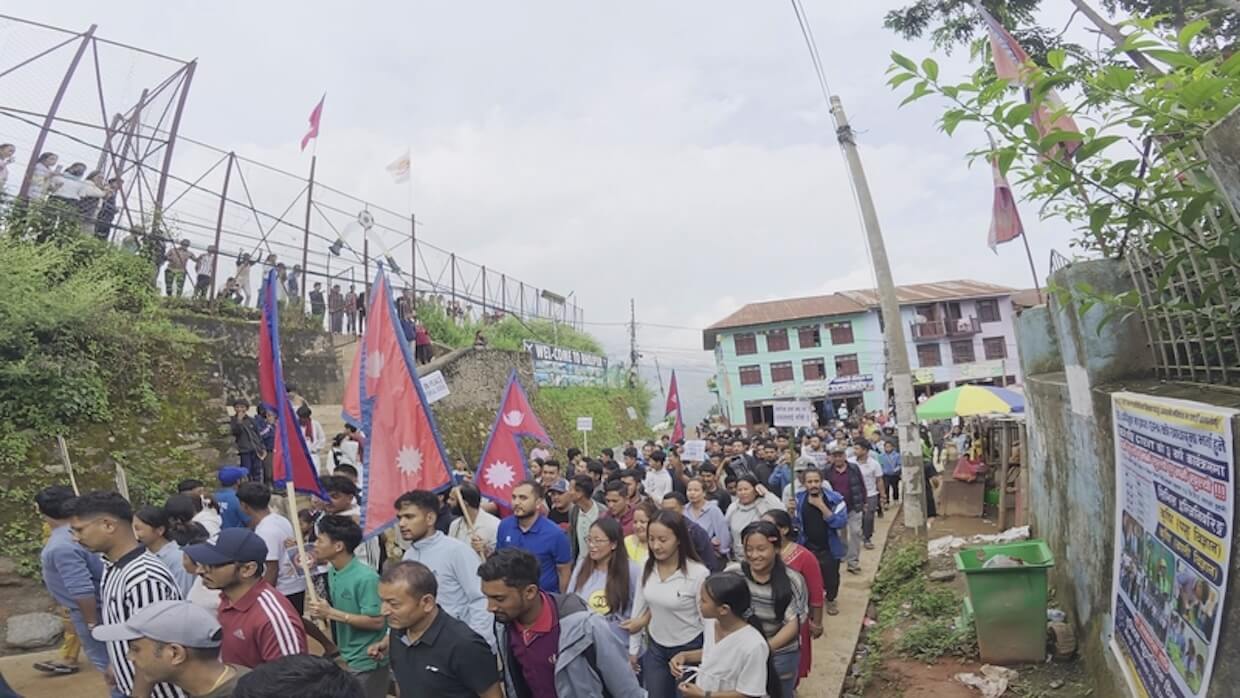
The ban on social media is often cited as the immediate spark of revolt. Should this be understood as a mere tactical blunder by Oli’s government, or as symptomatic of a deeper authoritarian reflex embedded within Nepal’s ruling elite?
DB Subedi: That’s a very good question, and I think it is indeed both. On the one hand, it was what I would call a tactical blunder of the Oli government, because the ban on 26 social media platforms was based on a miscalculation of the possible social and political consequences it could produce. The reason it was a miscalculation is that we have now seen how it actually drove people to take to the streets—not only in Kathmandu but across the country. It was a tactical blunder because it failed to anticipate the reactions, especially from younger generations, Gen Z and others, who are digital nomads and live in the digital space. For them, the digital space is everyday life, not just a platform for networking and entertainment, but increasingly also a space for political competition and contestation. The government failed to predict the potential political and social backlash and consequences of this. Or at least, they were probably not ignorant of it but simply undermined the consequences.
At the same time, this also reflects a symptom of the increasingly authoritarian style of politics of the Oli government. One example I would cite is that when social media was banned on 4th September, news still circulated on the platforms that remained operational at the time—I think this included Viber and a few others—where the frustrations of young people were voiced. Through those platforms, there was a call for a nationwide protest against the government’s decision.
Rather than engaging with the people—especially the younger generation—and explaining to the population at large why the ban would be necessary, for example, as the government claimed, to maintain social cohesion and avert social fragmentation caused by misinformation and disinformation circulating on social media, the Oli government failed to make its case. That could have been a well-intentioned policy, and there may have been good intent behind it. However, the government not only failed to explain this to the people, but at the same time, ex-Prime Minister Oli was seen publicly criticizing and undermining young people’s frustration. This was symbolic and spoke directly to his authoritarian stance on the use of social media. For young people, it was not simply a matter of compliance; they saw it as an attack on their freedom of speech. In my view, then, the decision to ban social media was partly a tactical blunder and partly a symbolic expression of the increasingly authoritarian politics of the ruling elites at that time.
Nepo-Babies as a Symptom of Neo-Elitism
Viral outrage against “nepo-babies” seems to reflect a moral economy of resentment against elite entitlement. To what extent did the digital spectacle of political heirs flaunting luxury lifestyles crystallize diffuse frustrations into a new form of class politics—distinct from the agrarian and proletarian struggles of earlier eras?
Dr. DB Subedi: The outrage against nepo-babies, which we have seen on social media for some time in Nepal, is not unique to Nepal. In Asia, we have also seen similar kinds of outrage against nepo-babies in Indonesia and elsewhere; the Philippines is another example. But in the case of Nepal, this is actually a symptom of a deep cultural conflict within Nepal’s politics. It also points to the inequalities and disparities that have grown between political elites and ordinary people in the past decades.
Of course, nepo-babies are also a symbol of neo-elitism and a growing political culture that endorses elite entitlement and elite resource capture in a resource-poor country like Nepal. In other words, the outrage against nepo-babies—or the framing of nepo-babies as a particular type of social class on social media—is a symptom of growing socioeconomic inequalities and political divides in the country. This has also supported a different kind of elitist political culture, one that people did not expect after the massive political change in 2015.
To put that into context, when the Maoists called for a revolution—armed revolution—in 1996, during the 10 years of insurgency, 17,000 people died. Many hundreds, even thousands, are still missing. And there are thousands upon thousands of families that have been disintegrated or displaced because of the insurgency.
There are also ex-combatants who actively fought in the war—from the Maoist side as well as from the government side—who are now living with disability and carry deep emotional and psychological distress inherited from the war. The memory of those precarious, insecure times has not faded away. For Nepalese society, this is not a very distant event in history. People remain very much aware of what was sacrificed—not just by those who fought in the war, but also by ordinary people during the Maoist insurgency.
Then there was a political shift in 2008 and 2015, but now you can contrast these situations with the children of political elites—politicians who are living a luxurious life and, most importantly, flaunting that life and their privileges on social media. That kind of contrasting scenario is obviously going to be outrageous for people who feel they lost a decade of their lives because of the insurgencies, and who see few opportunities available for the masses.
So, what we have seen in the recent revolutions is the clash of those two types of political cultures, and the very contrasting lives people are living. That is why young people have shown their frustrations against nepo-babies. But again, nepo-babies are a product of bad political culture, rising neo-elitism, and institutional failure to bring about equitable socioeconomic change and transformation in the country.
Different Triggers, Shared Inequalities
Nepal is the third South Asian country in four years to witness mass youth-led uprisings, after Sri Lanka in 2022 and Bangladesh in 2024. What do you see as the common drivers across these cases, and what is unique to Nepal’s trajectory?
Dr. DB Subedi: Actually, there are several common drivers. One of the main ones is that in all three revolutions, there was overwhelming involvement and participation of young people, especially in Bangladesh and Nepal. We have seen Gen Z play a leading role in these kinds of protest movements. In Sri Lanka, in the Aragalaya, it was a bit different because people from three different ethnic groups—Tamils, Sinhalese, and Muslims—came together. This movement was also mostly led by young people, but people from other generations were involved as well in the revolution that toppled the government of Rajapaksa.
Of course, there are contextual differences too—differences in terms of politics, history, and so on. But there are also common structural issues behind the rise of these movements in all three countries. At the center of that structural inequality, that structural issue, is the perception of injustice. In Sri Lanka, the Aragalaya movement was mostly fueled by the government’s failure—economic collapse and the government’s failure to manage the economy when the country transitioned from decades of civil war to peace and stability.
In Bangladesh, this was directed towards a bad government policy by Sheikh Hasina’s government regarding quotas in government jobs and opportunities for young people. So, it was actually aimed at a particular kind of policy. In Nepal, by contrast, it was triggered by another policy decision—the ban on social media.
Regardless of these three different trigger factors, what we have seen is growing socioeconomic inequality, lack of generational change in politics, the perceptions of young people, and the reality of their sense of socioeconomic exclusion, relative deprivation, and frustration toward increasingly elitist types of politics. These are the common issues we can observe in all three countries. And when these issues converge in motivating young people to take to the streets, social media plays an important role as a facilitator of this kind of collective movement.
The Key Is a Proper Handover of Power
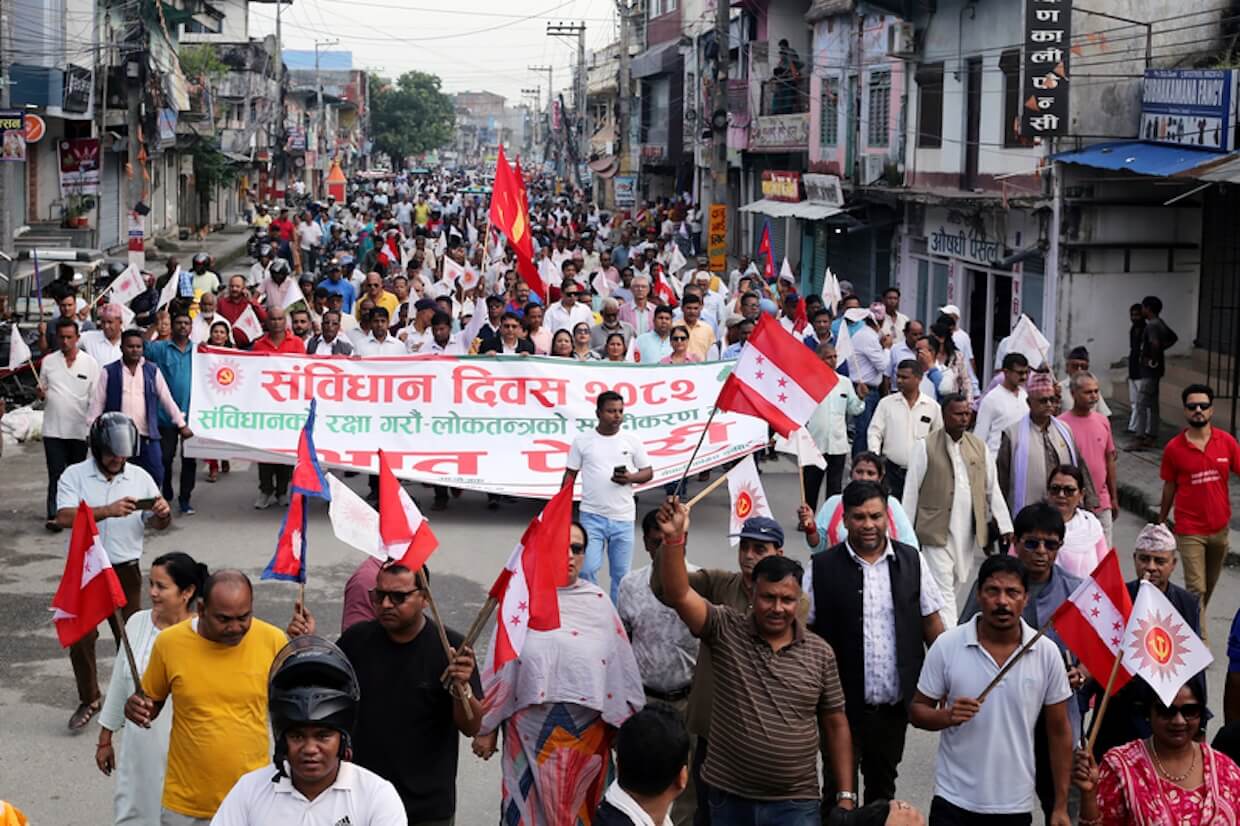
In Sri Lanka, the Aragalaya protest movement toppled the Rajapaksas but was quickly reabsorbed into elite politics. What lessons should Nepali youth learn from the Sri Lankan experience to avoid repeating this cycle of betrayal?
Dr. DB Subedi: Sri Lanka’s case is probably somewhat different from that of Nepal, particularly when it comes to the transfer of political authority at the end of the revolutions. There is now a new government that came to power after the elections—a progressive government, distinct from the previous populist nationalist government of Rajapaksa. What we have seen in Sri Lanka is a very quick and relatively smooth transfer of power from the previous regime to the new progressive government, which, as the recent elections show, has received an overwhelming mandate from the Sri Lankan people. The transition was, of course, fragile, but the Sri Lankans managed it very well in terms of shifting power from the previous regime to the new one.
In the case of Nepal, we now have a civil society government, a pattern more or less similar to what we saw in Bangladesh after the 2024 revolution. This civilian government has been given a mandate to hold elections within six months, and it is headed by the former Chief Justice of the country, Sushila Karki. Nepal can actually learn a few things here from Sri Lanka. One is that it will always be in the best interest of the people and the political system to manage these transitions and make them as short as possible, because a proper handover of power from previous governments to the next elected government is the key.
In the meantime, there are also additional challenges for the Nepalese government—the civilian government in power at the moment. Nepal also faces the challenge of holding those from previous governments accountable for the loss of life during the protest movement. Proper investigations into the abuse of power and coercion by the previous regimes are difficult issues, but they need to be addressed. At the same time, there is widespread public frustration and anger about corruption cases. There are dozens of cases dating back as early as the 1990s that have not been properly investigated, and political power has been used, misused, and abused to avoid scrutiny.
So, while the civilian government in power at the moment has many challenges, the main lesson it could learn from Sri Lanka in particular is the importance of ensuring that processes, mechanisms, and systems are in place to transfer power from previous authorities to newly elected authorities.
The Risks of Religious Populism
In Bangladesh, the fall of Sheikh Hasina has opened space for religious extremism and new forms of repression. How should we understand the dangers of authoritarian populists exploiting anti-corruption or anti-elitist discourses in fragile democracies?
Dr. DB Subedi: That’s a very good question, and Nepal also has—I wouldn’t say a strong possibility, but there may be—some scenarios where certain political forces, either existing or emerging, might use populist rhetoric to exploit the fluid situation in the transitional period. In other words, there may be risks of populist, nationalist kinds of political narratives being circulated as mainstream narratives in the meantime and taking over in the post-revolution political system. The risks are always there. In Bangladesh, we have seen religious extremist narratives circulating in the political domain and influencing politics, and this is typical of Bangladesh because of its sociocultural and socio-religious configurations.
In the case of Nepal, there are two potential scenarios where populist forces seeking to exploit the situation could emerge. In my view, one is that there is probably a lesser risk of right-wing populist politics exploiting culture or ethnicity to advance populist agendas in Nepal. Because Nepal is ethnically diverse, if any populist forces emerge at this stage, one possibility is that they might actually mobilize people across ethnic divides. In that sense, it might look less like the right-wing populism we have seen elsewhere.
But at the same time, the bigger risk is that Nepal was the only Hindu state in the world until 2015. When the new constitution was passed in 2015, it became a secular country. And even though it is now formally secular, it is weakly so, because in practice, in everyday life, religion is still present in the public domain. It has not been retracted into the private sphere. As a result, there are certain political parties and interest groups that want to reinstate the Hindu state in Nepal. That is another risk, where there may be potential for populist politics to emerge in this transition, mobilizing and exploiting religious factors, narratives, and ideologies. If that happens, that sort of populist politics might be more dangerous, because it could share certain elements of right-wing populism we have seen elsewhere, since it would be a form of religious populism in Nepal.
So, yes, like Sri Lanka, Nepal also faces risks. But at the same time, it also has an opportunity, because elections have been called in six months’ time, and if elections take place and there is a smooth transition of power, then Nepali society might be able to navigate these challenges in the days to come.
Unprecedented Support, Uncertain Future
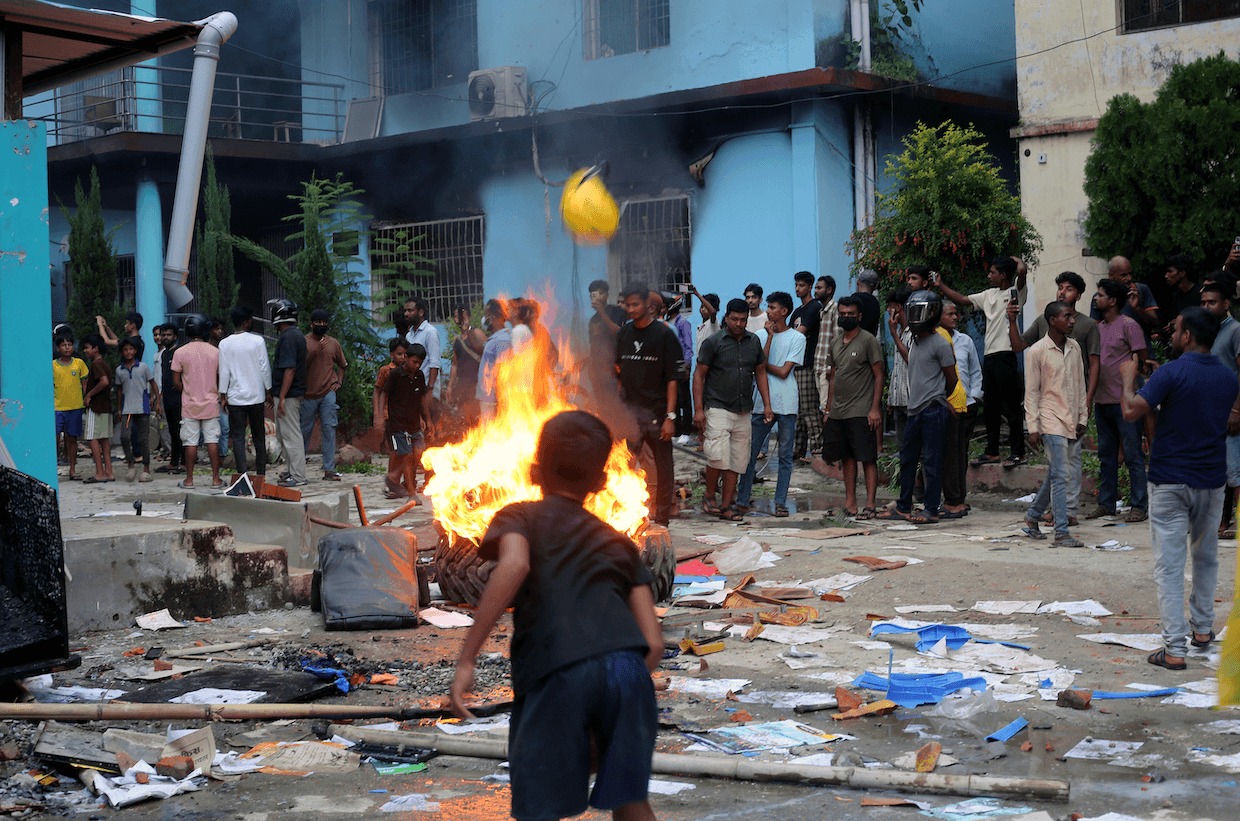
And finally, Professor Subedi, do you see in Nepal’s Gen Z uprising the embryonic forms of a post-elitist democracy—an order rooted not in patronage or coercion but in participatory, inclusive politics? Or does the violence of the movement suggest that the path forward remains perilously uncertain?
Dr. DB Subedi: At the moment, I would like to be optimistic about your question, and I would say there are signs of a post-elitist kind of politics beginning to emerge in this case. But again, a lot depends on what kind of political institutions will consolidate in the days to come. Looking at the past, one of the major challenges in Nepal is that even though there were political changes—political shifts in 2015, 2008, and even earlier—the change in institutional setup did not result in meaningful socioeconomic transformation. One reason it didn’t happen is because institutions changed, but the institutional culture inherited from the past essentially remained the same. As a result, corruption continued, exclusion continued, and people’s frustrations with the system and political elites deepened.
In these situations, how the voices of younger generations can be institutionalized and established in mainstream politics in the days to come will determine a lot. Still, I would view this change more optimistically than pessimistically, because despite some losses—there was destruction and violence when the protests intensified on the second day—there is nonetheless a sense of awareness among the public that change was inevitable, change was necessary, and that we have come to a time when much more meaningful change is required, both in terms of political institutions, systems of governance, and political participation. But changing political culture is also necessary.
And I think if more and more young people are able to participate in politics, they might be able to foster a political culture that is much more participatory and inclusive, and can establish not only economic systems but also political systems that are fair, inclusive, and capable of bringing about the change desired by those who sacrificed their lives, as well as those who participated in these protest movements. A lot depends on how the state and society will navigate this challenge and crisis, because sometimes past history also gives us a clue to predict the future. Unfortunately, the past record of how Nepalese society has navigated post-revolutionary political space is not very encouraging.
But this time, because the revolution was led particularly by young people outside of the political parties’ participation—it was not hierarchical, as would have been the case if it were led by political parties—at the same time, even though it was a leaderless movement, it very quickly sought some results, some consequences. So, the kind of public support this protest movement has received is unprecedented. In that sense, there is huge public support, and in fact, that kind of public support is also a good indicator of the legitimacy of the current government, and also the government that will take over when it is handed over to an elected government. That kind of legitimacy is good for any government and any political leaders who come to power with the intention of bringing about meaningful social, economic, and political change. And that is what we can hope for at this stage. But a lot depends on how this will be managed, and how society will navigate through it.

